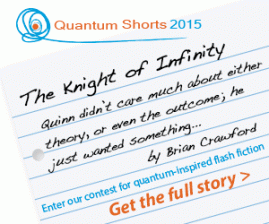A blog on everything quantum is the perfect place to announce the launch of the 2015 Quantum Shorts competition. The contest encourages readers to create quantum-themed “flash fiction”: a short story of no more than 1000 words that is inspired by quantum physics. Scientific American, the longest continuously published magazine in the U.S., Nature, the world’s leading multidisciplinary science journal, and Tor Books, the leading science fiction and fantasy publisher, are media partners for the contest run by the Centre for Quantum Technologies at the National University of Singapore. Entries can be submitted now through 11:59:59 PM ET on December 1, 2015 at http://shorts.quantumlah.org.
“Quantum physics seems to inspire creative minds, so we can’t wait to see what this year’s contest will bring,” says Scientific American Editor in Chief and competition judge Mariette DiChristina.
A panel of judges will select the winners and runner-ups in two categories: Open and Youth. The public will also vote and decide the People’s Choice Prize from entries shortlisted across both categories. Winners will receive a trophy, a cash prize and a one-year digital subscription to ScientificAmerican.com. The winner of the Open category will also be featured on ScientificAmerican.com.
 The quantum world offers lots of scope for enthralling characters and mind-blowing plot twists, according to Artur Ekert, director of the Centre for Quantum Technologies and co-inventor of quantum cryptography. “A writer has plenty to play with when science allows things to be in two places – or even two universes – at once,” he says. “The result might be funny, tense or even confusing. But it certainly won’t be boring.” Artur is one of the Open category judges.
The quantum world offers lots of scope for enthralling characters and mind-blowing plot twists, according to Artur Ekert, director of the Centre for Quantum Technologies and co-inventor of quantum cryptography. “A writer has plenty to play with when science allows things to be in two places – or even two universes – at once,” he says. “The result might be funny, tense or even confusing. But it certainly won’t be boring.” Artur is one of the Open category judges.
Another judge is Colin Sullivan, editor of Futures, Nature’s own science-themed fiction strand. “Science fiction is a powerful and innovative genre,” Colin says. “We are excited to see what kinds of stories quantum physics can inspire.”
The 2015 Quantum Shorts contest is also supported by scientific partners around the world. The Institute for Quantum Information and Matter is proud to sponsor this competition, along with our friends at the Centre for Engineered Quantum Systems, an Australian Research Council Centre of Excellence, the Institute for Quantum Computing at the University of Waterloo, and the Joint Quantum Institute, a research partnership between the University of Maryland and the National Institute of Standards and Technology.
Submissions to Quantum Shorts 2015 are limited to 1000 words and can be entered into the Quantum Shorts competition via the website at http://shorts.quantumlah.org, which also features a full set of rules and guidelines.
For more information about the organizer and partners, please visit the competition website at http://shorts.quantumlah.org.

Material for a foresighted Quantum Shorts narrative appears in the following laconic notice for the most recent (14 September 2015) LIGO Weekly Report
Executive Summary Although there are no guarantees, the improved sensitivity of the LIGO Advanced Detector runs gives real hope of a long-dreamed scientific achievement: the advent of gravitational wave astronomy.
Further readings:
• Advanced Engineering “Advanced LIGO: The LIGO Scientific Collaboration” (arXiv:1411.4547)
• Advanced Quantum Physics “Realizing Squeezing: An interview with Carlton Caves” (LIGO Magazine vol 3(1), September, 2013)
• Advanced Ambitions LISA Pathfinder will launch late in 2015
Quantum hopes It is entirely reasonable to hope (and even foresee in detail) that: (1) AdvLIGO will observe gravity waves, and (2) future space-born observatories will observe an abundance of gravity waves, utilizing (3) the advanced quantum systems engineering techniques that Carlton Caves’ essay so engagingly describes.
Surely there’s a wonderful Quantum Short inherent in these developments!
Pingback: Explaining Quantum Physics to Newton… in 140 characters | Quantum Frontiers
Pingback: Black-hole Sun, ticking clocks, coffee-stain avalanches and more – MyPhysNet
Pingback: Black-hole Sun, ticking clocks, coffee-stain avalanches and more – Physics World